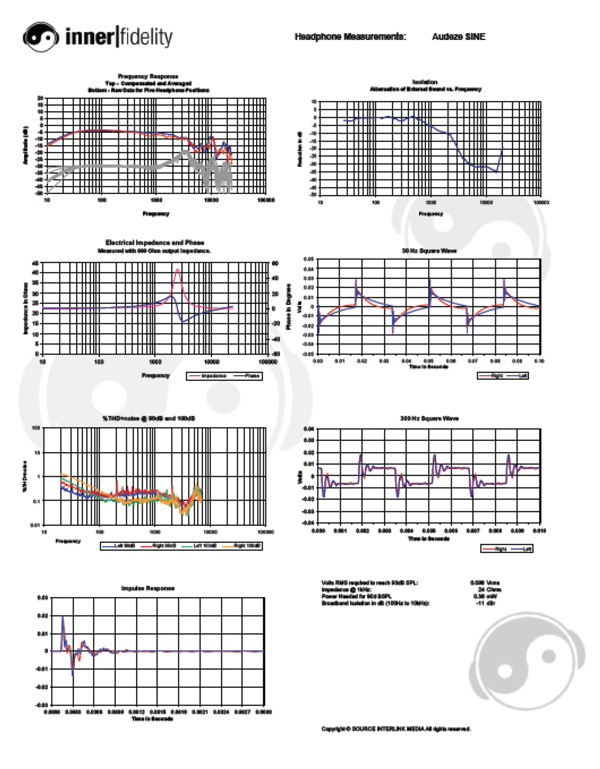| Columns Retired Columns & Blogs |
Like a Sports Car for Your Head: The Audeze SINE and Cipher Lightning Cable Measurements
Measurements


Click on graphs image to download .pdf for closer inspection.
Raw frequency response plots show movement of the headphone on the head has little affect on response other than in the very low bass indicating a well designed on-ear pad. Raw response is near flat from 30Hz to 1kHz with very little in the way of fluctuation—this is an unusually even response for a headphone of this type.
Harman target response would have a 3dB boost in the bass below 150Hz and a gently rising response from 400Hz to 1kHz. In comparison the SINE is a little low in bass response and needs a bit of lift from 400Hz to 1kHz. Though this was heard in my listening tests, the unusually even, dynamic, and coherent response seemed to make the deficits less troublesome.
Response from 1kHz to the peak at 3.5kHz is near ideal. Subsequent fall in response and dip between 4-8kHz is excessive and reduces consonant clarity, but also prevents the headphones from having harsh response when played moderately loud.
The peak at 10kHz is common and only slightly in excess, but treble energy above seems somewhat excessive. This energy does seem to retrieve some of the lost speech intelligibility from the dip at 4-8kHz.
30Hz square wave shows some channel missmatch almost certainly due to loss of seal on that particular measurement run. I would say the trace with the straighter waveform top is more indicative of typical performance. That trace shows very good linearity as would be expected given the largely flat frequency response and low distortion in the bass of the THD+noise plot.
300Hz square wave shows a slightly too high initial transient peak followed by two more, ever smaller, ringing features. This is a common feature on many good headphones (HD 600, Focal Spirit Pro) and while I don't consider it optimal it doesn't seem to be too detrimental to the listening experience.
300Hz waveform top is nicely flat indicating good treble balance, but impulse response shows sharpened peaks on the first transient and subsequent dip and also some high-frequency ringing superimposed. I suspect this is another indicator of excessive response above 10kHz.
THD+noise plot shows remarkably low distortion on the SINE, falling well below 1% in all but the 100dB plot at the lowest frequencies. This headphone does clean and loud very well.
The impedance plot is very unusual for a planar magnetic headphone, which are usually nearly dead flat. This is due to a small inductor/capacitor network inside the SINE that tunes out a response peak at 2.5kHz. I tried, but heard no evidence of this in listening; it's astonishing to me that there is coincident feature on the raw response plots at this frequency. It seems this is a finely tuned tweak.
Isolation plots show a slightly below average amount of isolation for a headphone of this type with -11dB of broadband attenuation of outside noise.
With 96mVrms needed to achieve 90dB at the ear, the SINE is modestly less voltage efficient than most headphones in this category, but a smartphone will drive these cans to solid listening levels.
- Log in or register to post comments




































